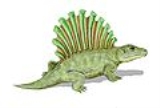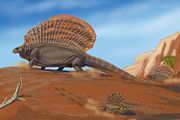
Platyhystrix
Encyclopedia
Platyhystrix was a temnospondyl amphibian
with a distinctive sail along its back, similar to the unrelated synapsid
s, Dimetrodon
and Edaphosaurus
. It lived during the latest Carboniferous and earliest Permian periods in Texas, about 300 million years ago.
 Platyhystrix may have been preyed upon by larger temnospondyls such as Eryops
Platyhystrix may have been preyed upon by larger temnospondyls such as Eryops
, or by larger carnivorous reptiles, which were becoming more common and diverse in the drier climate of the Permian. The skull was large and strongly built, with a frog-like face. Platyhystrix had a compact body, reaching 1 metres (3.3 ft) long including the tail, and its short, sturdy legs indicate a mainly terrestrial life.
Platyhystrix appeared rather unusual: the dorsal vertebrae were extraordinarily lengthened, and in life they probably formed a skin-covered sail. This structure was possibly for thermal regulation, as in other animals of similar appearance, such as the pelycosaur
s Dimetrodon
and Edaphosaurus
. The back of Platyhystrix was also covered with thick hard plates, similar to those of its near relative, Cacops
.
Amphibian
Amphibians , are a class of vertebrate animals including animals such as toads, frogs, caecilians, and salamanders. They are characterized as non-amniote ectothermic tetrapods...
with a distinctive sail along its back, similar to the unrelated synapsid
Synapsid
Synapsids are a group of animals that includes mammals and everything more closely related to mammals than to other living amniotes. They are easily separated from other amniotes by having an opening low in the skull roof behind each eye, leaving a bony arch beneath each, accounting for their name...
s, Dimetrodon
Dimetrodon
Dimetrodon was a predatory synapsid genus that flourished during the Permian period, living between 280–265 million years ago ....
and Edaphosaurus
Edaphosaurus
Edaphosaurus is a genus of prehistoric synapsid which lived around 303 to 265 million years ago, during the late Carboniferous to early Permian periods. The name Edaphosaurus means "ground lizard" and is derived from the Greek edaphos/εδαφος and σαυρος/sauros...
. It lived during the latest Carboniferous and earliest Permian periods in Texas, about 300 million years ago.
Palaeobiology

Eryops
Eryops meaning "drawn-out face" because most of its skull was in front of its eyes is a genus of extinct, semi-aquatic amphibian found primarily in the Lower Permian-aged Admiral Formation of Archer County, Texas, but fossils are also found in New Mexico and parts of the eastern United...
, or by larger carnivorous reptiles, which were becoming more common and diverse in the drier climate of the Permian. The skull was large and strongly built, with a frog-like face. Platyhystrix had a compact body, reaching 1 metres (3.3 ft) long including the tail, and its short, sturdy legs indicate a mainly terrestrial life.
Platyhystrix appeared rather unusual: the dorsal vertebrae were extraordinarily lengthened, and in life they probably formed a skin-covered sail. This structure was possibly for thermal regulation, as in other animals of similar appearance, such as the pelycosaur
Pelycosaur
The pelycosaurs are an informal grouping composed of basal or primitive Late Paleozoic synapsid amniotes. Some species were quite large and could grow up to 3 meters or more, although most species were much smaller...
s Dimetrodon
Dimetrodon
Dimetrodon was a predatory synapsid genus that flourished during the Permian period, living between 280–265 million years ago ....
and Edaphosaurus
Edaphosaurus
Edaphosaurus is a genus of prehistoric synapsid which lived around 303 to 265 million years ago, during the late Carboniferous to early Permian periods. The name Edaphosaurus means "ground lizard" and is derived from the Greek edaphos/εδαφος and σαυρος/sauros...
. The back of Platyhystrix was also covered with thick hard plates, similar to those of its near relative, Cacops
Cacops
Cacops is a genus of dissorophid temnospondyl that is known from the Early Permian of the central United States.It was about long and well adapted to a terrestrial lifestyle, with a heavily built skull, strong legs, a short tail, and a row of armor plates along its back...
.

